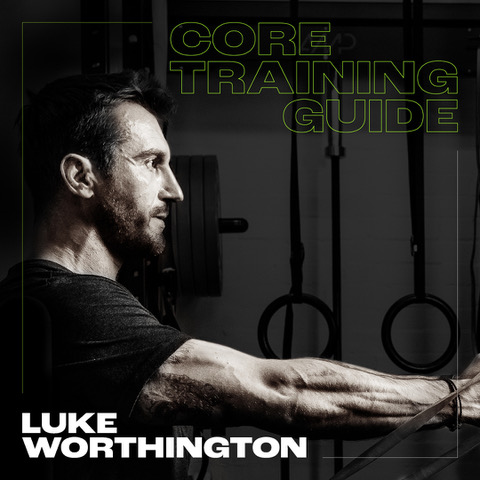I figured we could all use a reprieve from the barrage of “at home” exercises and workouts everyone is posting of late.
#COVID19sucksdonkeyballs
My good friend and London based personal trainer, Luke Worthington, released his Core Training Guidebook recently and in light of that wrote up this guest post that takes a bit of a different “take” on the topic.
Luke’s one of the smartest coaches I know and I think you should check it out (not an affiliate link).
Actually, now that I think about it: the timing of this pans out.
- You’re all stuck at home and can’t go to the gym.
- Everyone wants a core you can cut diamonds with.
- Training the core doesn’t require a lot of equipment.
Sha-ZAM.
This is perfect.

How Position Affects Your Mood
We have known for some time that core training and core control was about so much more than a six pack. But did you know it also plays a role in your mood, how you sleep, and even how you laugh or cry?
It’s generally accepted that movement is good for us on both a mental and a physical level. However, do we know just how closely the two are linked?
Our nervous system has two parts – parasympathetic (rest & digest) that takes care of all our subconscious actions. And sympathetic (fight or flight) that is our reaction to situations around us.
Generally in life we want to spend as much time as we can in a parasympathetic state – because quite simply, its easier!
However, moving from one to the other has just as much to do with how we move, as how we think.

Our neural anatomy isn’t just enclosed in our skull – the sympathetic ganglion (the part of or neurological system that activates sympathetic activity), are actually situated in the thoracic spine. So extending that part of your skeleton (arching your back) actively stimulates them, and therefore creates a sympathetic state. (one of the reasons why we stretch in the morning to wake ourselves up).
Note from TG: Also another “advantage” to powerlifters accentuating the low back arch during their bench press setup?
Moving ourselves into an extension position (also known as ‘scissor’ position) stimulates us, which makes us more alert, more able to exert force, run faster, jump higher, and generally be more ‘alpha’.1 Excellent for when we’re playing sports or fighting for our lives.
However, it also means that recovery, sleep, decision making and empathy are significantly reduced…
Not so good for maintaining relationships and resting – which we also need to do at times!
How Position Feeds This
One of the primary activities we must do in order to stay alive is breathe.
In order to perform this apparently simple activity we have quite a complex array of musculature supporting it. Our primary respiratory muscles are the diaphragm and the intercostal, which drive air in and out of the lungs with the purpose of exchanging gas and essentially stopping us from dying.
Whereas we may assume that inhaling oxygen is the primary cue for breathing – its actually blowing off carbon dioxide.
“A failure to do this results in our system becoming more acidic leading to a state of anxiety, increased sympathetic activity (fight of flight), impaired nerve conduction, restricted blood flow in cerebral cortex (poor decision making), increased phobic dysfunction panic attacks, and fatigue.”
LaghiF, Tobin F. Disorders of respiratory muscles. American Journal of Respiratory and Critical Care Medicine. Vol 168: 10-48 2003
The majority of the ‘good stuff’ in respiration happens in the lower 1/3 of the lungs.
Where the majority of blood vessels are situated.
However, in order for gas exchange to happen adequately here the ribcage and the pelvis have to be in the correct positions.
In simple terms they have to oppose each other – the pelvis in neutral, and the ribcage oriented over the top of it – almost like a cereal bowl with another one upside down on top of it! In coaching parlance we often call this the ‘cannister’ position.
If this doesn’t happen – then gas exchange cannot happen at this part of the chest cavity. But as a pre cursor to life it has to happen somewhere! If its not happening at the bottom, then it will happen at the top, however, in order for this to occur we have to engage additional musculature to help out (think upper back, trapezius, neck) as we need to elevate the upper chest to create space for airflow.
As well as the more direct consequences of creating unwelcome hypertonicity (over activity) in those areas (trapezius trigger points anyone).
This drive to create space in the upper chest requires thoracic extension, which as we know stimulates the sympathetic nervous system, creating a heightened state of anxiety, which in turn causes an increased desire to breathe…. but… we’re in the wrong position to!
This means we drive further into thoracic extension (scissor position), so we further stimulate the sympathetic nervous system and so we go around in a constant feedback loop…
To propagate the situation even further, the chest /neck breather is far less efficient at blowing off excess CO2 than the diaphragmatic breather (simply due to the fewer blood vessels available for gas exchange in the upper parts of the chest).
Not blowing off enough CO2 makes us more acidic, therefore more anxious, therefore having a greater desire to breathe, therefore driving further into thoracic extension
Poor position = poor breathing mechanics = greater level of anxiety.
However it also places us at a greater risk of further mechanical issues.
“In situations where respiratory drive is increased such as stress, disease or physical exercise, the ability of the respiratory muscles to perform their postural tasks is reduced. The presence of respiratory disease is a stronger predictor for lower back pain than other established risk factors”
International Journal of Osteopathic Medicine 12 (2009)
This constant feedback loop is what is occurring on a physiological level when a person suffers from a panic attack or hyperventilation. What they actually need to do is exhale fully, allow their torso to flex, and reducing the mechanical stress on the sympathetic ganglion, blowing off some CO2, restoring PH, and eventually settling back to homeostasis (balance).
Contrary to this:
Crying is natures overflow valve.
When we’re over stimulated, hyperinflated, and unable to moderate our nervous systems – we push the emergency button.
When we cry, we exhale fully, and flex out of scissor position and into cannister.
Not sure if you’ve noticed but you don’t see people cry in an upright, extended position – they restore canister – get themselves neutral, and exhale. This is why we feel better after we do it, and why we often feel tired afterwards, and also why it makes our abs hurt!
Note from TG: All you have to do is watch me watching the ending of Notting Hill and you’ll see what Luke is referring to.
Training our core to resist movement through all three movement planes, whilst in incrementally more challenging positions will help us lift more and do more cool stuff – but it can also just make us better at life.
And who doesn’t want that.
Core Training Guidebook




